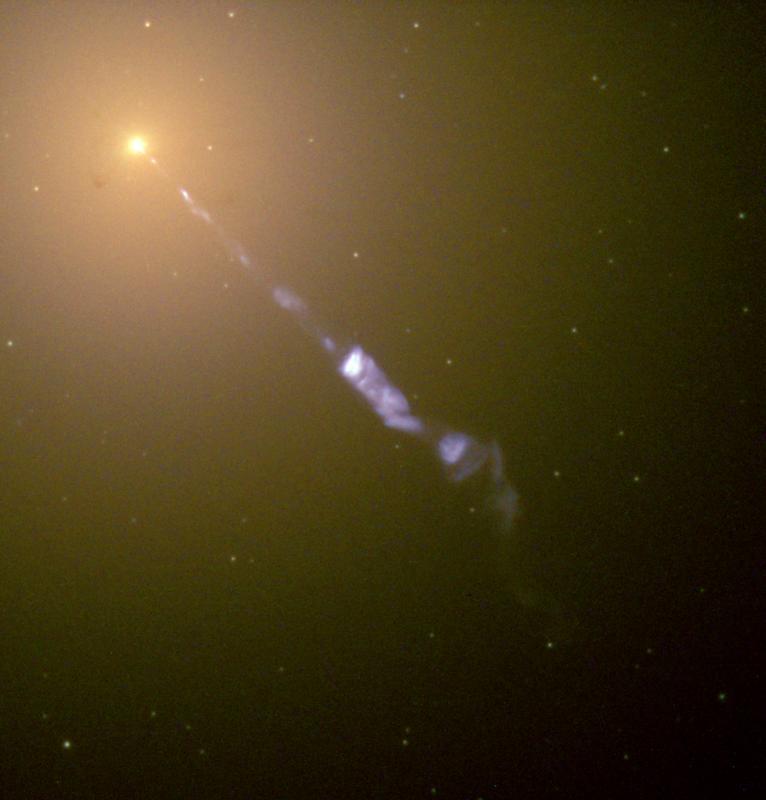







| BOOKS | F. A. Q. | ARTICLES | TALKS | ABOUT KEN | DONATE | BEYOND OUR KEN |
|---|
By Ken Croswell
Published on Physics World (May 22, 2013)

M87 is a nearby example of a giant elliptical galaxy. Credit: Hubble Space Telescope. NASA and the Hubble Heritage Team (STScI/AURA).
Like reckless rock stars, some galaxies live fast and get old long before their time. Now an international team of astronomers is watching this metamorphosis as it occurred billions of light-years away. Two distant galaxies are crashing together, turning all their gas into stars so rapidly that they will soon appear to be much older than they really are.
In the modern universe, giant galaxies--those that emit about as much light as the Milky Way--come in two main types: spiral and elliptical. Spiral galaxies are graceful, having formed their stars little by little over time, so they harbour stars from young to old. In contrast, giant elliptical galaxies converted all of their gas into stars long ago, so today they consist only of old stars with little or no gas to make new stars.
When astronomers gaze into space billions of light-years away, they witness the universe as it was billions of years ago. Yet they still see giant elliptical galaxies that consist of old stars--even as far away as 10 billion light-years from Earth. However, at that time the universe was less than 4 billion years old, giving giant elliptical galaxies little time to form.
Astronomers have long been puzzled by this age problem--but now Hai Fu of the University of California at Irvine and colleagues think they may have the answer. The team has discovered a collision between two spiral galaxies 11 billion light-years away in the constellation Cetus.
"We believe that this object is a transitional object between a spiral galaxy and an elliptical galaxy," he says. "Because these transitions happen so dramatically and violently, over a very short period of time, it's really hard to actually catch them in action."
The two galaxies are only about 62,000 light-years apart--slightly more than twice the Sun's distance from the Milky Way's centre--and have torn material out of each other, a sign they are colliding and will merge. As gas clouds in one galaxy smash into those in the other, they spawn lots of new stars.
Called HXMM-01, the system is bright at submillimetre wavelengths, because dust in the gas absorbs starlight and re-emits it at infrared and submillimetre wavelengths. In fact, Fu's team says the collision is the most luminous and gas-rich merger of submillimetre bright galaxies ever seen. It emits 10 trillion times more infrared energy than the Sun does over all wavelengths. In a single hour, the system produces as much energy as the Sun will during the next 2 billion years.
"The star formation is really intense," says Fu. From the high infrared luminosity, his team deduces that the collision is converting about 2000 solar masses of gas into stars each year, roughly 1000 times greater than the Milky Way's rate.
The galaxies possess a lot of gas. They have as much mass in gas as in stars. But their prolific creation of new stars will use all the gas up in just 200 million years. The end result will be a giant elliptical galaxy with roughly 10 trillion solar masses--about 10 times more massive than the Milky Way. If we could see the galaxy as it is today, 11 billion years later, it would consist solely of old stars.
"This is an extremely rare galaxy--if the interpretation is correct," says Abraham Loeb, who chairs the astronomy department at Harvard University. "It's an unusual animal in the zoo of galaxies."
But Loeb cautions that conditions may be less extreme than they seem if the collision is funnelling gas into a supermassive black hole at either galaxy's centre. Then the black hole would heat the gas and spark a quasar, an object that emits far more light than the Milky Way but from a region as small as the solar system.
"We know that mergers usually trigger activity in the centre of a galaxy," Loeb says. "So we would be seeing a quasar being born."
In this case, though, the quasar is enshrouded in thick dust that blocks its intense light. The dust would heat up, emitting infrared radiation. Since Fu's team used the immense infrared luminosity to derive the high star formation rate, Loeb says the presence of a buried quasar that produced most of the radiation would imply a more modest rate of star formation.
Fortunately, there's a way to discern even a dust-enshrouded quasar, because quasars emit high-energy X-rays that penetrate the dust. Fu's team is hoping to conduct such observations later this year. Meanwhile, Fu says he finds no sign of a quasar: quasars normally have hot dust, and he sees none in this object.
The research is described in Nature.
Ken Croswell earned his Ph.D. in astronomy from Harvard University and is the author of The Alchemy of the Heavens and The Lives of Stars.
"An engaging account of the continuing discovery of our Galaxy...wonderful." --Owen Gingerich, The New York Times Book Review. See all reviews of The Alchemy of the Heavens here.
"A stellar picture of what we know or guess about those distant lights."--Kirkus. See all reviews of The Lives of Stars here.
| BOOKS | F. A. Q. | ARTICLES | TALKS | ABOUT KEN | DONATE | BEYOND OUR KEN |
|---|